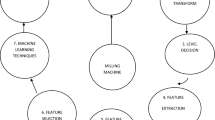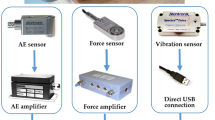Abstract
It is known that the force and vibration sensor signals in a turning process are sensitive to the gradually increasing flank wear. Based on this fact, this paper investigates a flank wear assessment technique in turning through force and vibration signals. Mainly to reduce the computational burden associated with the existing sensor-based methods for flank wear assessment, a so-called wavelet network is investigated. The basic idea in this new method is to optimize simultaneously the wavelet parameters (that represent signal features) and the signal-interpretation parameters (that are equivalent to neural network weights) to eliminate the feature extraction phase without increasing the computational complexity of the neural network. A neural network architecture similar to a standard one-hidden-layer feedforward neural network is used to relate sensor signal measurements to flank wear classes. A novel training algorithm for such a network is developed. The performance of this n ew method is compared with a previously developed flank wear assessment method which uses a separate feature extraction step. The proposed wavelet network can also be useful for developing signal interpretation schemes for manufacturing process monitoring, critical component monitoring, and product quality monitoring.
Similar content being viewed by others
References
Bishop, C. M. (1995) Neural Networks for Pattern Recognition, Oxford University Press, Oxford.
Boothroyd, G. and Knight, W. A. (1989) Fundamentals of Ma-chining and Machine Tools, Marcel Dekker, New York.
Daubechies, I. (1992) Ten Lectures on Wavelets, SIAM Press, Philadelphia.
Devijver, P. A. and Kittler, J. (1982) Pattern Recognition - A Statistical Approach, Prentice-Hall, Englewood Cliffs, NJ.
Dickhaus, H. and Heinrich, H. (1996) Classifying biosignals with wavelet networks - a method for noninvasive diagnosis. IEEE Engineering in Medicine and Biology Magazine, 15(5), 103–111.
Duda, R. O. and Hart, P. E. (1973) Pattern Classification and Scene Analysis, John Wiley, New York.
Johnson, D. E., Johnson, J. R. and Moore, H. P. (1980) A Hand-book of Active Filters, Prentice-Hall, Englewood Cliffs, NJ.
Kadambe, S. L. and Srinivasan, P. (1992) Application of adaptive wavelets for speech. Optical Engineering, 33(7), 2204–2211.
Kadambe, S. L., Srinivasan, P., Telfer, B. and Szu, H. H. (1993) Representation and classification of unvoiced sounds using adaptive wavelets, in Proceedings SPIE, 1961, Visual Infor-mation Processing II, pp. 324–335.
Kamarthi, S. V. and Pittner, S. (1996) Sensor data representation schemes for flank wear estimation in turning processes, Technical Report, Department of Mechanical, Industrial and Manufacturing Engineering, Northeastern University, Boston, MA.
Kamarthi, S. V. and Pittner, S. (1997) Fourier and wavelet transform for flank wear estimation - a comparison. Me-chanical Systems and Signal Processing, 11(6), 791–809.
Kamarthi, S. V., Kumara, S. R. T. and Cohen, P. H. (1998) Flank wear estimation through wavelet representation of acoustic emission signals. Journal of Manufacturing Science and En-gineering, submitted.
Rumelhart, D. E. and McClelland, J. L. (1986) Parallel Distrib-uted Processing - Explorations in the Microstructure of Cog-nition, Vol. 1, MIT Press, Cambridge, MA.
Szu, H. H., Telfer, B. and Kadambe, S. L. (1992) Neural network adaptive wavelets for signal representation and classification. Optical Engineering, 31(9), 1907–1916.
Telfer, B. A. and Szu, H. H. (1994) Energy functions for mini-mizing misclassification error with minimum-complexity networks. Neural Networks, 7(5), 809–817.
Vilim, R. B. and Wegerich, S. W. (1995) A neural network clas-sifier with analytic translation and scaling capabilities for optimal signal viewing, in Intelligent Engineering Systems Through Artificial Neural Networks, Volume 5, Fuzzy Logic and Evolutionary Programming, Dagli, C. H., Akay, M., Chen, C. L. P., Fernández, B. R. and Ghosh, J. (eds), ASME Press, New York, pp. 719–726.
Zhang, Q. and Benveniste, A. (1992) Wavelet networks. IEEE Transactions on Neural Networks, 3(6), 889–898.
Author information
Authors and Affiliations
Rights and permissions
About this article
Cite this article
Pittner, S., Kamarthi, S.V. & Gao, Q. Wavelet networks for sensor signal classification in flank wear assessment. Journal of Intelligent Manufacturing 9, 315–322 (1998). https://doi.org/10.1023/A:1008970608121
Issue Date:
DOI: https://doi.org/10.1023/A:1008970608121




